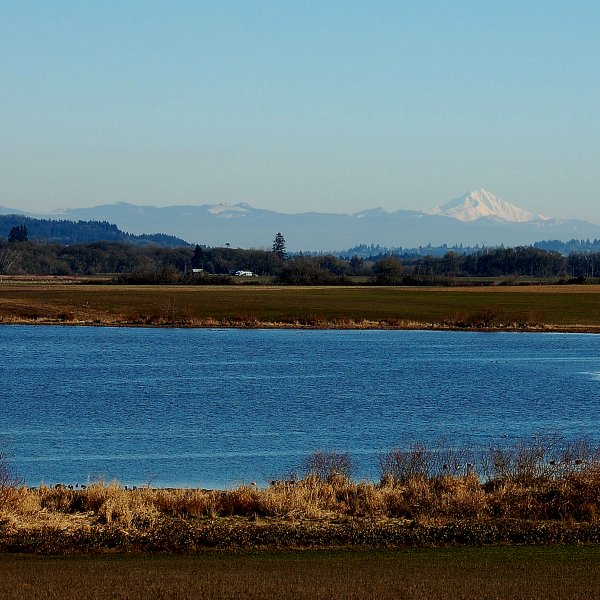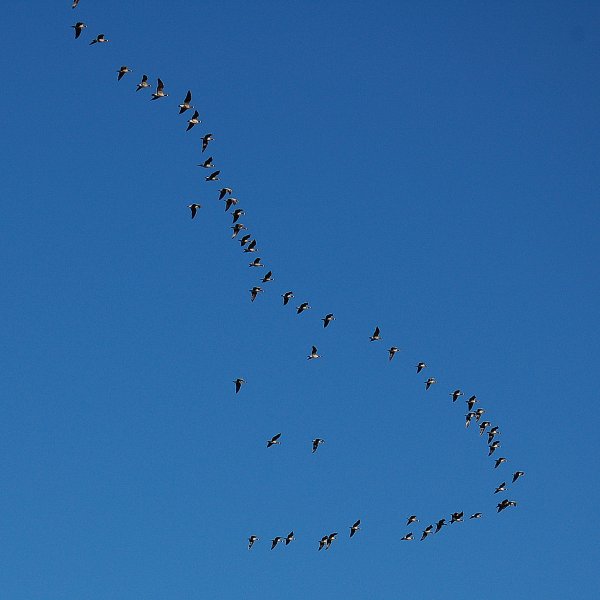I took this photo last January. Mama and I were on the way back from playing the penny machines when I decided to stop at Baskett Slough. I didn't have the zoom lens with me, but I like the way the scenic photo turned out. The blues of that sky and the water, along with the olives, tans and browns of the grasses--they contrast nicely with snowy Mt. Hood, there on the right, 72 miles from where I stood. Oh how I wished for the zoom lens when I realized the mountain was out. That's what folks say here when clouds do not obscure it.
Location: West-central Willamette Valley, about 10 miles west of Salem, in Polk County.

Info from the Audubon Society of Portland's Web site: Description: This national wildlife refuge was established in 1965 to provide winter habitat for Dusky Canada Geese, a subspecies that winters primarily in the Willamette Valley. Four other subspecies also regularly winter here. Grass fields provide forage for wintering goose flocks, and restored wetlands provide roosting habitat for geese, as well as habitat for other waterfowl and waterbirds. An Oregon white oak woodland, oak savanna, and upland prairie provide habitat for other wildlife and rare native plants. (Contributed by Karen Viste-Sparkman).

Outstanding Features: Baskett Slough and nearby private lands provide habitat for one of the largest concentrations of the Streaked Horned Lark (Eremophila alpestris strigata), currently a candidate for listing under the Endangered Species Act, and is listed as critical on the Oregon sensitive species list. No formal surveys have been done on the refuge alone, but anecdotal information estimates a population of at least 10 breeding pairs. Together with adjacent private lands the breeding population easily exceeds 25 pairs. The entire population in the Willamette Valley is estimated to be less than 200 pairs. The refuge also supports a rare community of upland prairie and Oregon white oak woodland/oak savanna. Restored wetlands support concentrations of wintering waterfowl, and the mid-winter waterfowl aurvey detected 35,988 ducks, geese, and swans in 2001. The refuge regularly supports more than 100 shorebirds during spring and fall migrations. (Contributed by Karen Viste-Sparkman).
Conservation Issues: Natural succession has been taking place since early settlers arrived and eliminated fire from the ecosystem. Woody vegetation is invading prairies and conifers are over-topping oak trees, destroying these rare plant communities. The refuge is managing woody vegetation by repeated mowing and a prescribed burning program. These communities would be lost without these actions. Invasion of non-native plant species is an ongoing problem that requires repeated chemical and mechanical treatment of vegetation.
Oak restoration is needed in the form of removing conifers and possibly thinning oaks and returning fire to the oak community. Prairie restoration needs to take place in degraded prairie areas and retired farm fields by controlling invasive plants through mechanical, and chemical control; controlling encroaching woody species through mechanical removal and fire; and reintroducing native prairie plant species. (Contributed by Karen Viste-Sparkman).
September 11th's dahlia, Freedom Fighter, in honor of all those who go out every day in the name of freedom for all of us--thank you. Facts from Swan Island Dahlias--Bloom: 10" Bright Red, Bush: 4 1/2'

1 comment:
Amazing dahlia! Thanks so much for this post. The blue in the sky is just amazing!
Post a Comment